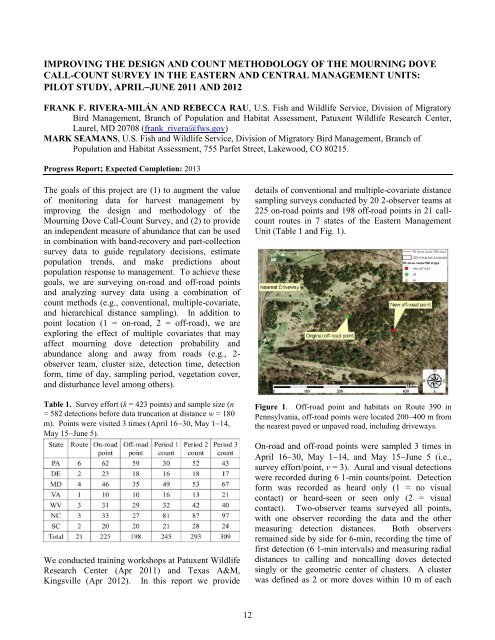Webless Migratory Game Bird Program - U.S. Fish and Wildlife Service
Webless Migratory Game Bird Program - U.S. Fish and Wildlife Service
Webless Migratory Game Bird Program - U.S. Fish and Wildlife Service
Create successful ePaper yourself
Turn your PDF publications into a flip-book with our unique Google optimized e-Paper software.
IMPROVING THE DESIGN AND COUNT METHODOLOGY OF THE MOURNING DOVE<br />
CALL-COUNT SURVEY IN THE EASTERN AND CENTRAL MANAGEMENT UNITS:<br />
PILOT STUDY, APRIL�JUNE 2011 AND 2012<br />
FRANK F. RIVERA-MILÁN AND REBECCA RAU, U.S. <strong>Fish</strong> <strong>and</strong> <strong>Wildlife</strong> <strong>Service</strong>, Division of <strong>Migratory</strong><br />
<strong>Bird</strong> Management, Branch of Population <strong>and</strong> Habitat Assessment, Patuxent <strong>Wildlife</strong> Research Center,<br />
Laurel, MD 20708 (frank_rivera@fws.gov)<br />
MARK SEAMANS, U.S. <strong>Fish</strong> <strong>and</strong> <strong>Wildlife</strong> <strong>Service</strong>, Division of <strong>Migratory</strong> <strong>Bird</strong> Management, Branch of<br />
Population <strong>and</strong> Habitat Assessment, 755 Parfet Street, Lakewood, CO 80215.<br />
Progress Report; Expected Completion: 2013<br />
The goals of this project are (1) to augment the value<br />
of monitoring data for harvest management by<br />
improving the design <strong>and</strong> methodology of the<br />
Mourning Dove Call-Count Survey, <strong>and</strong> (2) to provide<br />
an independent measure of abundance that can be used<br />
in combination with b<strong>and</strong>-recovery <strong>and</strong> part-collection<br />
survey data to guide regulatory decisions, estimate<br />
population trends, <strong>and</strong> make predictions about<br />
population response to management. To achieve these<br />
goals, we are surveying on-road <strong>and</strong> off-road points<br />
<strong>and</strong> analyzing survey data using a combination of<br />
count methods (e.g., conventional, multiple-covariate,<br />
<strong>and</strong> hierarchical distance sampling). In addition to<br />
point location (1 = on-road, 2 = off-road), we are<br />
exploring the effect of multiple covariates that may<br />
affect mourning dove detection probability <strong>and</strong><br />
abundance along <strong>and</strong> away from roads (e.g., 2observer<br />
team, cluster size, detection time, detection<br />
form, time of day, sampling period, vegetation cover,<br />
<strong>and</strong> disturbance level among others).<br />
Table 1. Survey effort (k = 423 points) <strong>and</strong> sample size (n<br />
= 582 detections before data truncation at distance w = 180<br />
m). Points were visited 3 times (April 16�30, May 1�14,<br />
May 15�June 5).<br />
We conducted training workshops at Patuxent <strong>Wildlife</strong><br />
Research Center (Apr 2011) <strong>and</strong> Texas A&M,<br />
Kingsville (Apr 2012). In this report we provide<br />
12<br />
details of conventional <strong>and</strong> multiple-covariate distance<br />
sampling surveys conducted by 20 2-observer teams at<br />
225 on-road points <strong>and</strong> 198 off-road points in 21 callcount<br />
routes in 7 states of the Eastern Management<br />
Unit (Table 1 <strong>and</strong> Fig. 1).<br />
Figure 1. Off-road point <strong>and</strong> habitats on Route 390 in<br />
Pennsylvania, off-road points were located 200�400 m from<br />
the nearest paved or unpaved road, including driveways.<br />
On-road <strong>and</strong> off-road points were sampled 3 times in<br />
April 16�30, May 1�14, <strong>and</strong> May 15�June 5 (i.e.,<br />
survey effort/point, v = 3). Aural <strong>and</strong> visual detections<br />
were recorded during 6 1-min counts/point. Detection<br />
form was recorded as heard only (1 = no visual<br />
contact) or heard-seen or seen only (2 = visual<br />
contact). Two-observer teams surveyed all points,<br />
with one observer recording the data <strong>and</strong> the other<br />
measuring detection distances. Both observers<br />
remained side by side for 6-min, recording the time of<br />
first detection (6 1-min intervals) <strong>and</strong> measuring radial<br />
distances to calling <strong>and</strong> noncalling doves detected<br />
singly or the geometric center of clusters. A cluster<br />
was defined as 2 or more doves within 10 m of each

















